Business Procurement and Contractual Practice
VerifiedAdded on 2023/01/12
|13
|4288
|1
AI Summary
This report provides an understanding of business procurement and contractual practice in the construction industry. It discusses the most appropriate procurement methods and types of contracts, four types of torts in the construction phase, evaluation of provisions in different types of contracts, the golden principle of FIDIC, and factors for selecting different types of contracts.
Contribute Materials
Your contribution can guide someone’s learning journey. Share your
documents today.
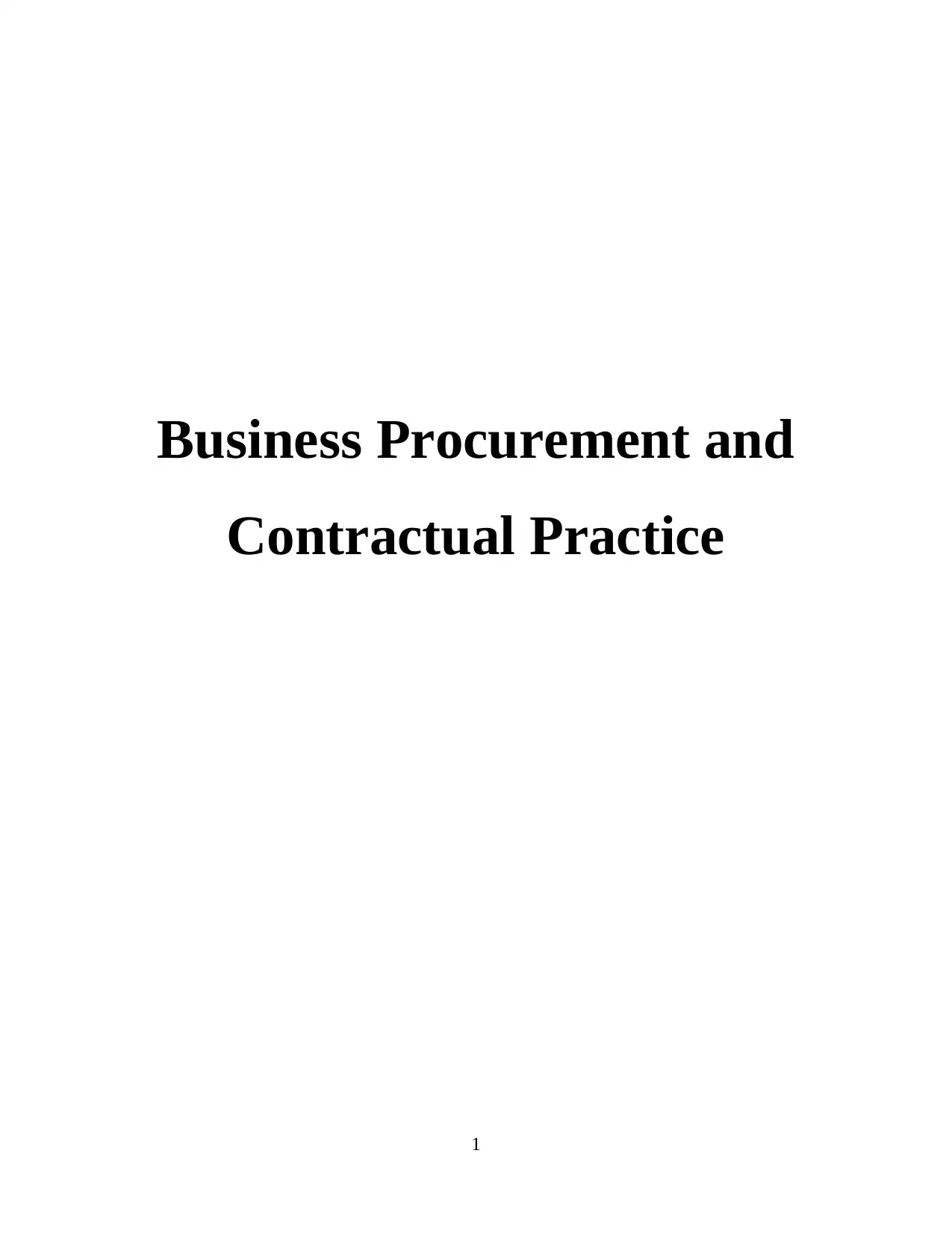
Business Procurement and
Contractual Practice
1
Contractual Practice
1
Secure Best Marks with AI Grader
Need help grading? Try our AI Grader for instant feedback on your assignments.
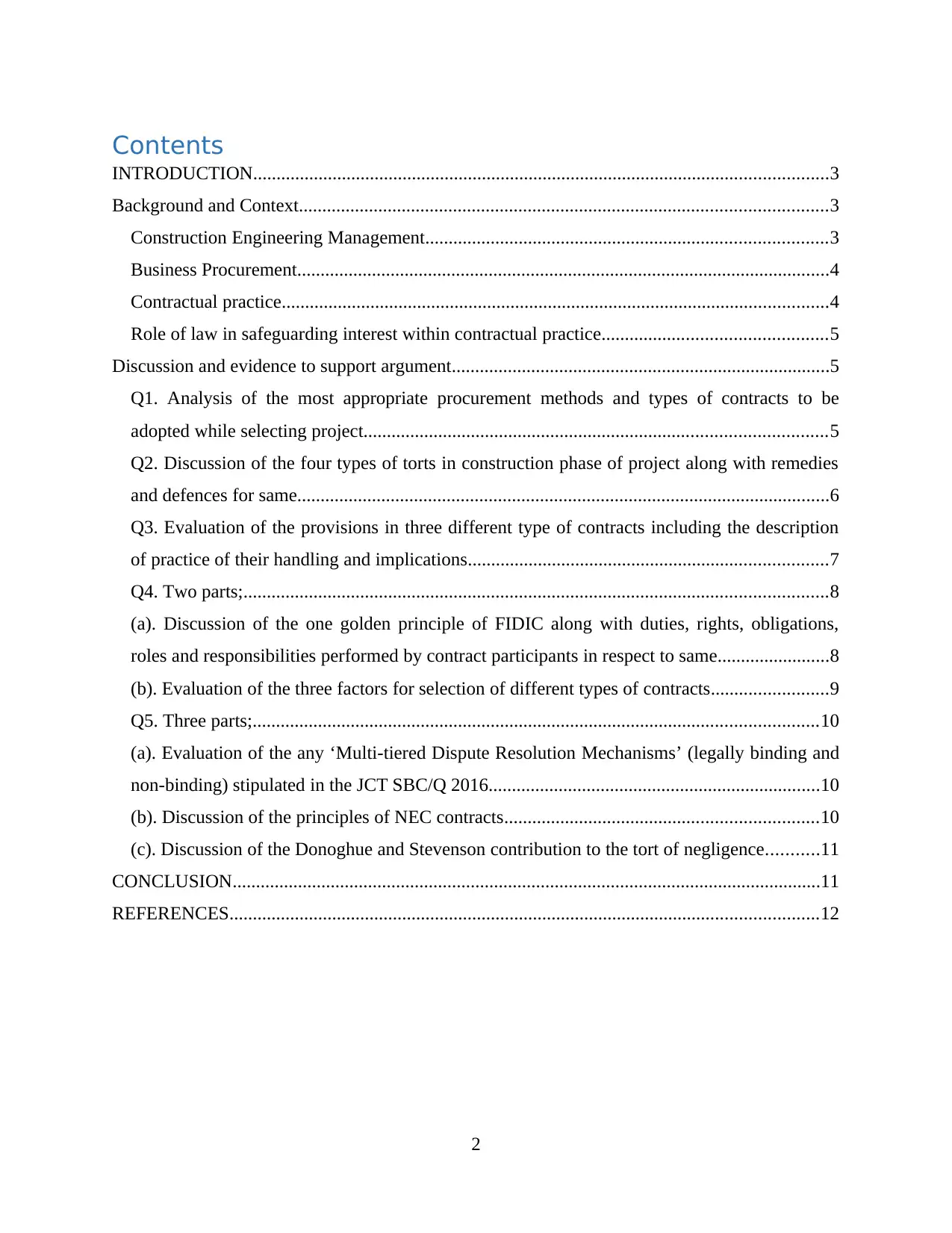
Contents
INTRODUCTION...........................................................................................................................3
Background and Context.................................................................................................................3
Construction Engineering Management......................................................................................3
Business Procurement..................................................................................................................4
Contractual practice.....................................................................................................................4
Role of law in safeguarding interest within contractual practice................................................5
Discussion and evidence to support argument.................................................................................5
Q1. Analysis of the most appropriate procurement methods and types of contracts to be
adopted while selecting project...................................................................................................5
Q2. Discussion of the four types of torts in construction phase of project along with remedies
and defences for same..................................................................................................................6
Q3. Evaluation of the provisions in three different type of contracts including the description
of practice of their handling and implications.............................................................................7
Q4. Two parts;.............................................................................................................................8
(a). Discussion of the one golden principle of FIDIC along with duties, rights, obligations,
roles and responsibilities performed by contract participants in respect to same........................8
(b). Evaluation of the three factors for selection of different types of contracts.........................9
Q5. Three parts;.........................................................................................................................10
(a). Evaluation of the any ‘Multi-tiered Dispute Resolution Mechanisms’ (legally binding and
non-binding) stipulated in the JCT SBC/Q 2016.......................................................................10
(b). Discussion of the principles of NEC contracts...................................................................10
(c). Discussion of the Donoghue and Stevenson contribution to the tort of negligence...........11
CONCLUSION..............................................................................................................................11
REFERENCES..............................................................................................................................12
2
INTRODUCTION...........................................................................................................................3
Background and Context.................................................................................................................3
Construction Engineering Management......................................................................................3
Business Procurement..................................................................................................................4
Contractual practice.....................................................................................................................4
Role of law in safeguarding interest within contractual practice................................................5
Discussion and evidence to support argument.................................................................................5
Q1. Analysis of the most appropriate procurement methods and types of contracts to be
adopted while selecting project...................................................................................................5
Q2. Discussion of the four types of torts in construction phase of project along with remedies
and defences for same..................................................................................................................6
Q3. Evaluation of the provisions in three different type of contracts including the description
of practice of their handling and implications.............................................................................7
Q4. Two parts;.............................................................................................................................8
(a). Discussion of the one golden principle of FIDIC along with duties, rights, obligations,
roles and responsibilities performed by contract participants in respect to same........................8
(b). Evaluation of the three factors for selection of different types of contracts.........................9
Q5. Three parts;.........................................................................................................................10
(a). Evaluation of the any ‘Multi-tiered Dispute Resolution Mechanisms’ (legally binding and
non-binding) stipulated in the JCT SBC/Q 2016.......................................................................10
(b). Discussion of the principles of NEC contracts...................................................................10
(c). Discussion of the Donoghue and Stevenson contribution to the tort of negligence...........11
CONCLUSION..............................................................................................................................11
REFERENCES..............................................................................................................................12
2
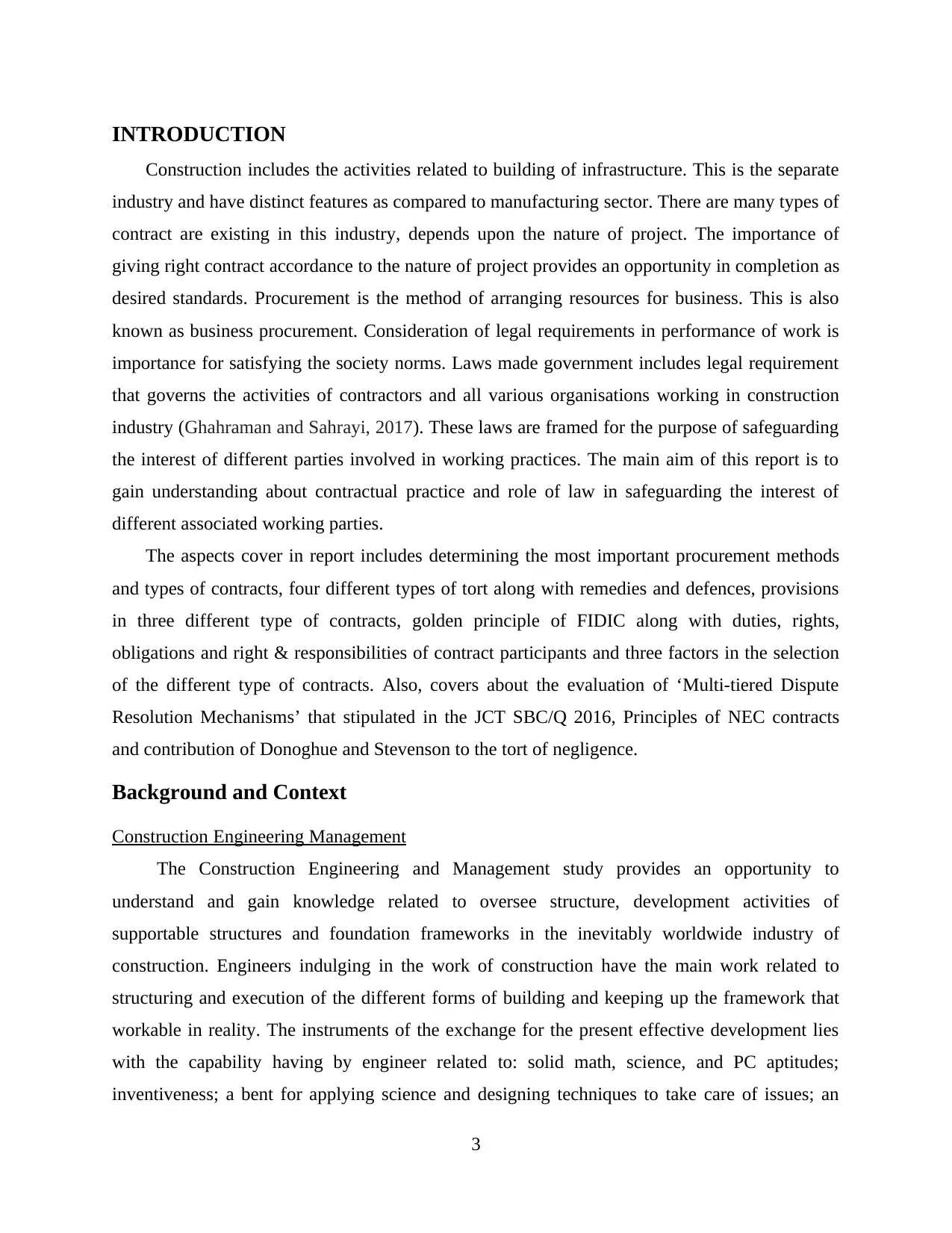
INTRODUCTION
Construction includes the activities related to building of infrastructure. This is the separate
industry and have distinct features as compared to manufacturing sector. There are many types of
contract are existing in this industry, depends upon the nature of project. The importance of
giving right contract accordance to the nature of project provides an opportunity in completion as
desired standards. Procurement is the method of arranging resources for business. This is also
known as business procurement. Consideration of legal requirements in performance of work is
importance for satisfying the society norms. Laws made government includes legal requirement
that governs the activities of contractors and all various organisations working in construction
industry (Ghahraman and Sahrayi, 2017). These laws are framed for the purpose of safeguarding
the interest of different parties involved in working practices. The main aim of this report is to
gain understanding about contractual practice and role of law in safeguarding the interest of
different associated working parties.
The aspects cover in report includes determining the most important procurement methods
and types of contracts, four different types of tort along with remedies and defences, provisions
in three different type of contracts, golden principle of FIDIC along with duties, rights,
obligations and right & responsibilities of contract participants and three factors in the selection
of the different type of contracts. Also, covers about the evaluation of ‘Multi-tiered Dispute
Resolution Mechanisms’ that stipulated in the JCT SBC/Q 2016, Principles of NEC contracts
and contribution of Donoghue and Stevenson to the tort of negligence.
Background and Context
Construction Engineering Management
The Construction Engineering and Management study provides an opportunity to
understand and gain knowledge related to oversee structure, development activities of
supportable structures and foundation frameworks in the inevitably worldwide industry of
construction. Engineers indulging in the work of construction have the main work related to
structuring and execution of the different forms of building and keeping up the framework that
workable in reality. The instruments of the exchange for the present effective development lies
with the capability having by engineer related to: solid math, science, and PC aptitudes;
inventiveness; a bent for applying science and designing techniques to take care of issues; an
3
Construction includes the activities related to building of infrastructure. This is the separate
industry and have distinct features as compared to manufacturing sector. There are many types of
contract are existing in this industry, depends upon the nature of project. The importance of
giving right contract accordance to the nature of project provides an opportunity in completion as
desired standards. Procurement is the method of arranging resources for business. This is also
known as business procurement. Consideration of legal requirements in performance of work is
importance for satisfying the society norms. Laws made government includes legal requirement
that governs the activities of contractors and all various organisations working in construction
industry (Ghahraman and Sahrayi, 2017). These laws are framed for the purpose of safeguarding
the interest of different parties involved in working practices. The main aim of this report is to
gain understanding about contractual practice and role of law in safeguarding the interest of
different associated working parties.
The aspects cover in report includes determining the most important procurement methods
and types of contracts, four different types of tort along with remedies and defences, provisions
in three different type of contracts, golden principle of FIDIC along with duties, rights,
obligations and right & responsibilities of contract participants and three factors in the selection
of the different type of contracts. Also, covers about the evaluation of ‘Multi-tiered Dispute
Resolution Mechanisms’ that stipulated in the JCT SBC/Q 2016, Principles of NEC contracts
and contribution of Donoghue and Stevenson to the tort of negligence.
Background and Context
Construction Engineering Management
The Construction Engineering and Management study provides an opportunity to
understand and gain knowledge related to oversee structure, development activities of
supportable structures and foundation frameworks in the inevitably worldwide industry of
construction. Engineers indulging in the work of construction have the main work related to
structuring and execution of the different forms of building and keeping up the framework that
workable in reality. The instruments of the exchange for the present effective development lies
with the capability having by engineer related to: solid math, science, and PC aptitudes;
inventiveness; a bent for applying science and designing techniques to take care of issues; an
3
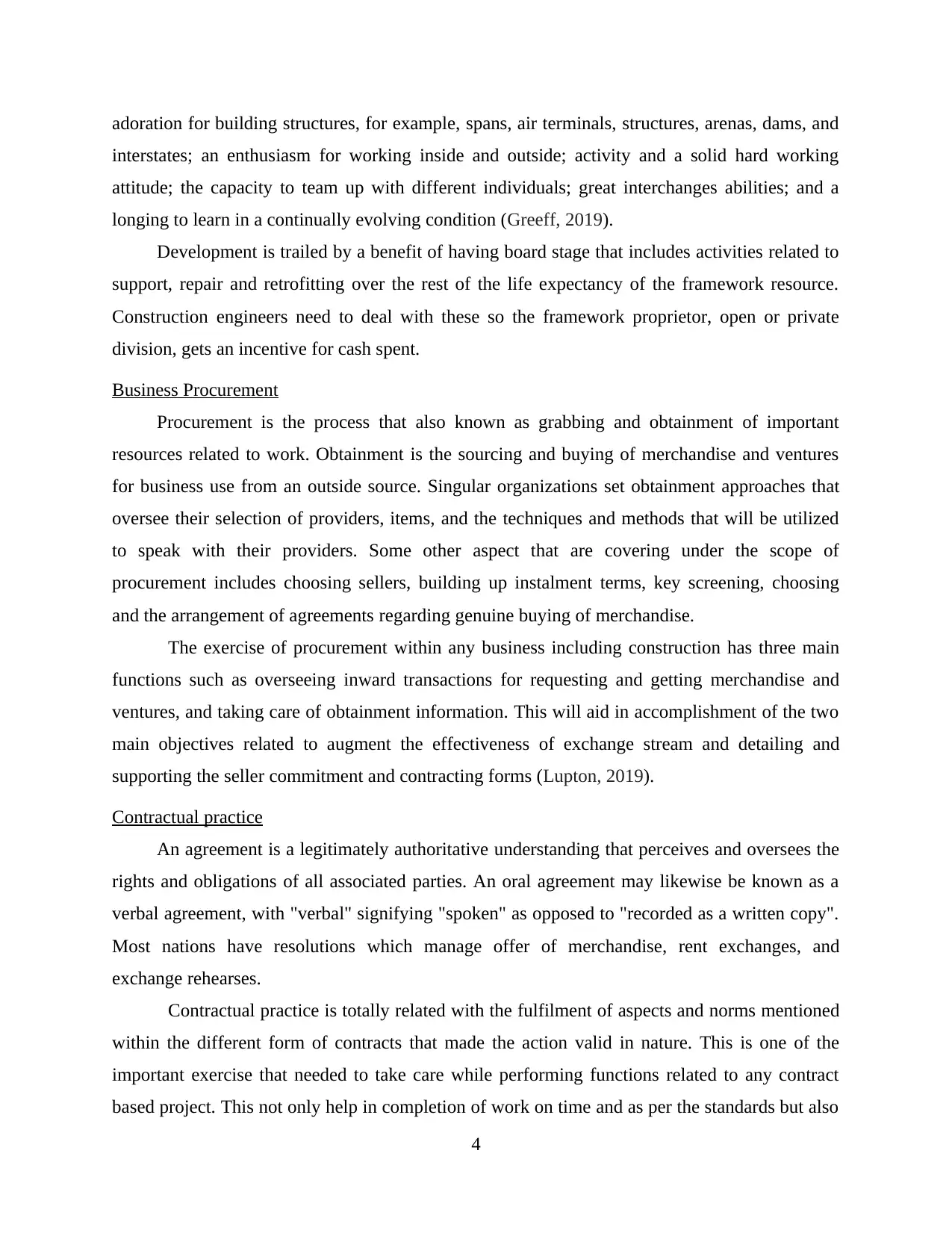
adoration for building structures, for example, spans, air terminals, structures, arenas, dams, and
interstates; an enthusiasm for working inside and outside; activity and a solid hard working
attitude; the capacity to team up with different individuals; great interchanges abilities; and a
longing to learn in a continually evolving condition (Greeff, 2019).
Development is trailed by a benefit of having board stage that includes activities related to
support, repair and retrofitting over the rest of the life expectancy of the framework resource.
Construction engineers need to deal with these so the framework proprietor, open or private
division, gets an incentive for cash spent.
Business Procurement
Procurement is the process that also known as grabbing and obtainment of important
resources related to work. Obtainment is the sourcing and buying of merchandise and ventures
for business use from an outside source. Singular organizations set obtainment approaches that
oversee their selection of providers, items, and the techniques and methods that will be utilized
to speak with their providers. Some other aspect that are covering under the scope of
procurement includes choosing sellers, building up instalment terms, key screening, choosing
and the arrangement of agreements regarding genuine buying of merchandise.
The exercise of procurement within any business including construction has three main
functions such as overseeing inward transactions for requesting and getting merchandise and
ventures, and taking care of obtainment information. This will aid in accomplishment of the two
main objectives related to augment the effectiveness of exchange stream and detailing and
supporting the seller commitment and contracting forms (Lupton, 2019).
Contractual practice
An agreement is a legitimately authoritative understanding that perceives and oversees the
rights and obligations of all associated parties. An oral agreement may likewise be known as a
verbal agreement, with "verbal" signifying "spoken" as opposed to "recorded as a written copy".
Most nations have resolutions which manage offer of merchandise, rent exchanges, and
exchange rehearses.
Contractual practice is totally related with the fulfilment of aspects and norms mentioned
within the different form of contracts that made the action valid in nature. This is one of the
important exercise that needed to take care while performing functions related to any contract
based project. This not only help in completion of work on time and as per the standards but also
4
interstates; an enthusiasm for working inside and outside; activity and a solid hard working
attitude; the capacity to team up with different individuals; great interchanges abilities; and a
longing to learn in a continually evolving condition (Greeff, 2019).
Development is trailed by a benefit of having board stage that includes activities related to
support, repair and retrofitting over the rest of the life expectancy of the framework resource.
Construction engineers need to deal with these so the framework proprietor, open or private
division, gets an incentive for cash spent.
Business Procurement
Procurement is the process that also known as grabbing and obtainment of important
resources related to work. Obtainment is the sourcing and buying of merchandise and ventures
for business use from an outside source. Singular organizations set obtainment approaches that
oversee their selection of providers, items, and the techniques and methods that will be utilized
to speak with their providers. Some other aspect that are covering under the scope of
procurement includes choosing sellers, building up instalment terms, key screening, choosing
and the arrangement of agreements regarding genuine buying of merchandise.
The exercise of procurement within any business including construction has three main
functions such as overseeing inward transactions for requesting and getting merchandise and
ventures, and taking care of obtainment information. This will aid in accomplishment of the two
main objectives related to augment the effectiveness of exchange stream and detailing and
supporting the seller commitment and contracting forms (Lupton, 2019).
Contractual practice
An agreement is a legitimately authoritative understanding that perceives and oversees the
rights and obligations of all associated parties. An oral agreement may likewise be known as a
verbal agreement, with "verbal" signifying "spoken" as opposed to "recorded as a written copy".
Most nations have resolutions which manage offer of merchandise, rent exchanges, and
exchange rehearses.
Contractual practice is totally related with the fulfilment of aspects and norms mentioned
within the different form of contracts that made the action valid in nature. This is one of the
important exercise that needed to take care while performing functions related to any contract
based project. This not only help in completion of work on time and as per the standards but also
4
Secure Best Marks with AI Grader
Need help grading? Try our AI Grader for instant feedback on your assignments.
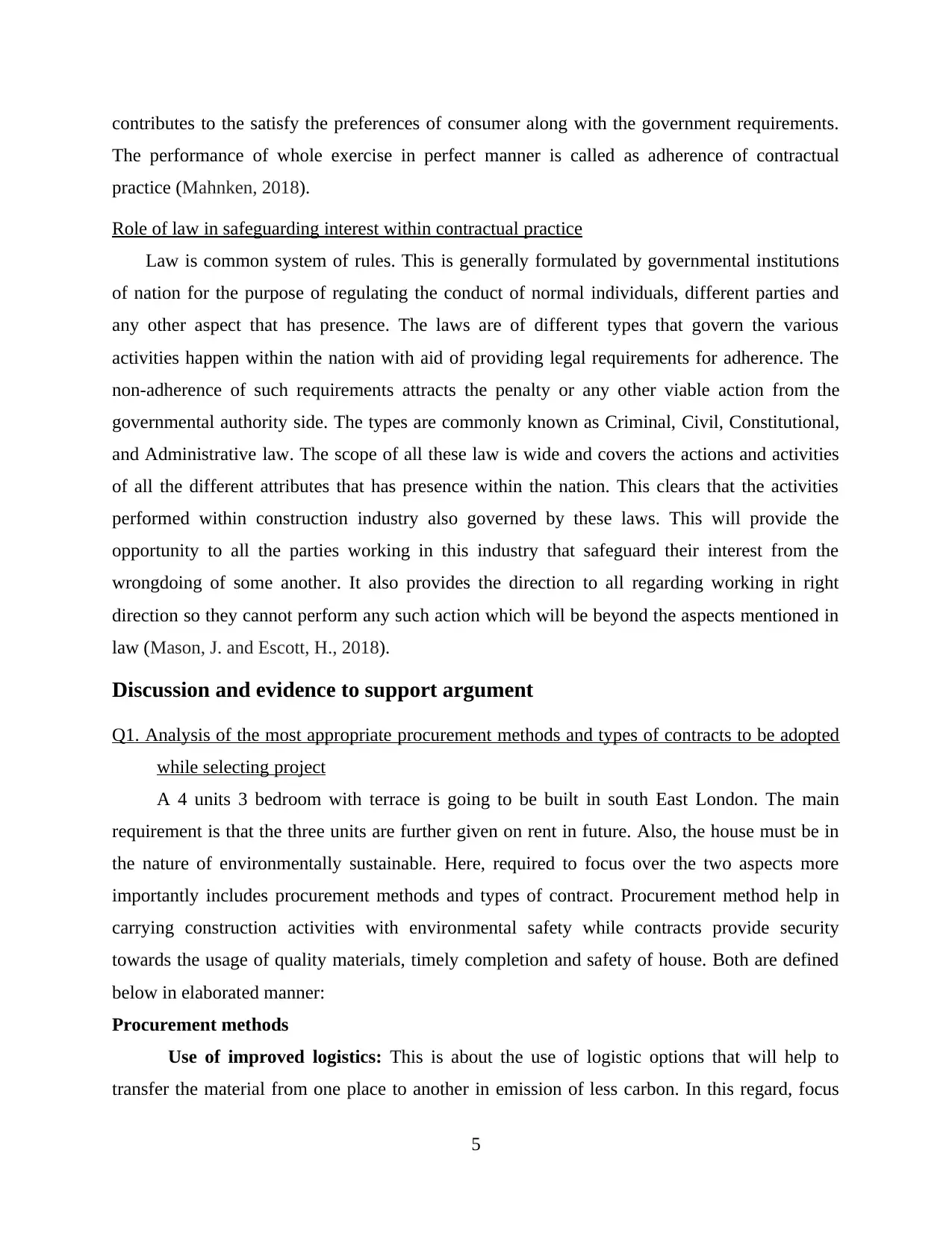
contributes to the satisfy the preferences of consumer along with the government requirements.
The performance of whole exercise in perfect manner is called as adherence of contractual
practice (Mahnken, 2018).
Role of law in safeguarding interest within contractual practice
Law is common system of rules. This is generally formulated by governmental institutions
of nation for the purpose of regulating the conduct of normal individuals, different parties and
any other aspect that has presence. The laws are of different types that govern the various
activities happen within the nation with aid of providing legal requirements for adherence. The
non-adherence of such requirements attracts the penalty or any other viable action from the
governmental authority side. The types are commonly known as Criminal, Civil, Constitutional,
and Administrative law. The scope of all these law is wide and covers the actions and activities
of all the different attributes that has presence within the nation. This clears that the activities
performed within construction industry also governed by these laws. This will provide the
opportunity to all the parties working in this industry that safeguard their interest from the
wrongdoing of some another. It also provides the direction to all regarding working in right
direction so they cannot perform any such action which will be beyond the aspects mentioned in
law (Mason, J. and Escott, H., 2018).
Discussion and evidence to support argument
Q1. Analysis of the most appropriate procurement methods and types of contracts to be adopted
while selecting project
A 4 units 3 bedroom with terrace is going to be built in south East London. The main
requirement is that the three units are further given on rent in future. Also, the house must be in
the nature of environmentally sustainable. Here, required to focus over the two aspects more
importantly includes procurement methods and types of contract. Procurement method help in
carrying construction activities with environmental safety while contracts provide security
towards the usage of quality materials, timely completion and safety of house. Both are defined
below in elaborated manner:
Procurement methods
Use of improved logistics: This is about the use of logistic options that will help to
transfer the material from one place to another in emission of less carbon. In this regard, focus
5
The performance of whole exercise in perfect manner is called as adherence of contractual
practice (Mahnken, 2018).
Role of law in safeguarding interest within contractual practice
Law is common system of rules. This is generally formulated by governmental institutions
of nation for the purpose of regulating the conduct of normal individuals, different parties and
any other aspect that has presence. The laws are of different types that govern the various
activities happen within the nation with aid of providing legal requirements for adherence. The
non-adherence of such requirements attracts the penalty or any other viable action from the
governmental authority side. The types are commonly known as Criminal, Civil, Constitutional,
and Administrative law. The scope of all these law is wide and covers the actions and activities
of all the different attributes that has presence within the nation. This clears that the activities
performed within construction industry also governed by these laws. This will provide the
opportunity to all the parties working in this industry that safeguard their interest from the
wrongdoing of some another. It also provides the direction to all regarding working in right
direction so they cannot perform any such action which will be beyond the aspects mentioned in
law (Mason, J. and Escott, H., 2018).
Discussion and evidence to support argument
Q1. Analysis of the most appropriate procurement methods and types of contracts to be adopted
while selecting project
A 4 units 3 bedroom with terrace is going to be built in south East London. The main
requirement is that the three units are further given on rent in future. Also, the house must be in
the nature of environmentally sustainable. Here, required to focus over the two aspects more
importantly includes procurement methods and types of contract. Procurement method help in
carrying construction activities with environmental safety while contracts provide security
towards the usage of quality materials, timely completion and safety of house. Both are defined
below in elaborated manner:
Procurement methods
Use of improved logistics: This is about the use of logistic options that will help to
transfer the material from one place to another in emission of less carbon. In this regard, focus
5
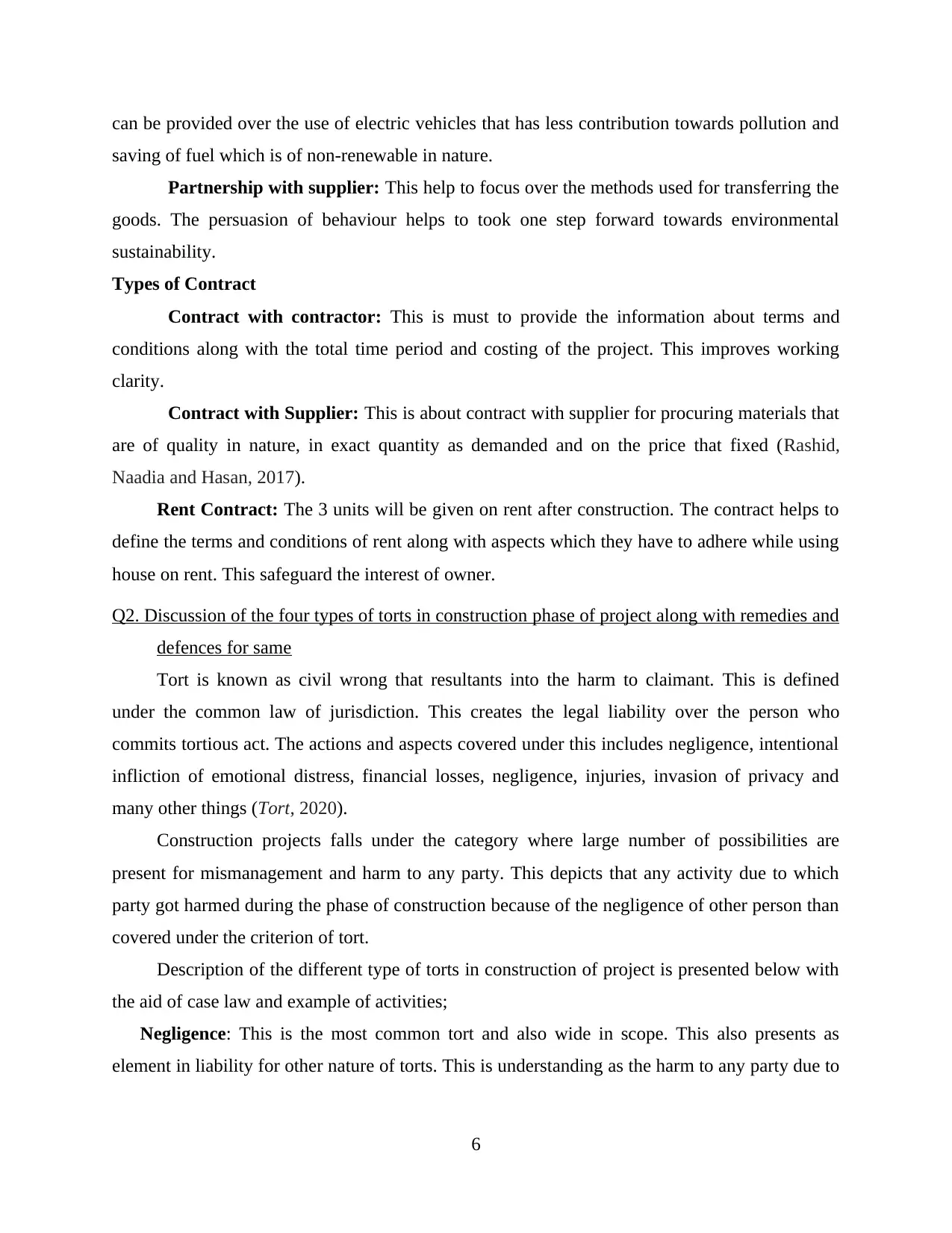
can be provided over the use of electric vehicles that has less contribution towards pollution and
saving of fuel which is of non-renewable in nature.
Partnership with supplier: This help to focus over the methods used for transferring the
goods. The persuasion of behaviour helps to took one step forward towards environmental
sustainability.
Types of Contract
Contract with contractor: This is must to provide the information about terms and
conditions along with the total time period and costing of the project. This improves working
clarity.
Contract with Supplier: This is about contract with supplier for procuring materials that
are of quality in nature, in exact quantity as demanded and on the price that fixed (Rashid,
Naadia and Hasan, 2017).
Rent Contract: The 3 units will be given on rent after construction. The contract helps to
define the terms and conditions of rent along with aspects which they have to adhere while using
house on rent. This safeguard the interest of owner.
Q2. Discussion of the four types of torts in construction phase of project along with remedies and
defences for same
Tort is known as civil wrong that resultants into the harm to claimant. This is defined
under the common law of jurisdiction. This creates the legal liability over the person who
commits tortious act. The actions and aspects covered under this includes negligence, intentional
infliction of emotional distress, financial losses, negligence, injuries, invasion of privacy and
many other things (Tort, 2020).
Construction projects falls under the category where large number of possibilities are
present for mismanagement and harm to any party. This depicts that any activity due to which
party got harmed during the phase of construction because of the negligence of other person than
covered under the criterion of tort.
Description of the different type of torts in construction of project is presented below with
the aid of case law and example of activities;
Negligence: This is the most common tort and also wide in scope. This also presents as
element in liability for other nature of torts. This is understanding as the harm to any party due to
6
saving of fuel which is of non-renewable in nature.
Partnership with supplier: This help to focus over the methods used for transferring the
goods. The persuasion of behaviour helps to took one step forward towards environmental
sustainability.
Types of Contract
Contract with contractor: This is must to provide the information about terms and
conditions along with the total time period and costing of the project. This improves working
clarity.
Contract with Supplier: This is about contract with supplier for procuring materials that
are of quality in nature, in exact quantity as demanded and on the price that fixed (Rashid,
Naadia and Hasan, 2017).
Rent Contract: The 3 units will be given on rent after construction. The contract helps to
define the terms and conditions of rent along with aspects which they have to adhere while using
house on rent. This safeguard the interest of owner.
Q2. Discussion of the four types of torts in construction phase of project along with remedies and
defences for same
Tort is known as civil wrong that resultants into the harm to claimant. This is defined
under the common law of jurisdiction. This creates the legal liability over the person who
commits tortious act. The actions and aspects covered under this includes negligence, intentional
infliction of emotional distress, financial losses, negligence, injuries, invasion of privacy and
many other things (Tort, 2020).
Construction projects falls under the category where large number of possibilities are
present for mismanagement and harm to any party. This depicts that any activity due to which
party got harmed during the phase of construction because of the negligence of other person than
covered under the criterion of tort.
Description of the different type of torts in construction of project is presented below with
the aid of case law and example of activities;
Negligence: This is the most common tort and also wide in scope. This also presents as
element in liability for other nature of torts. This is understanding as the harm to any party due to
6
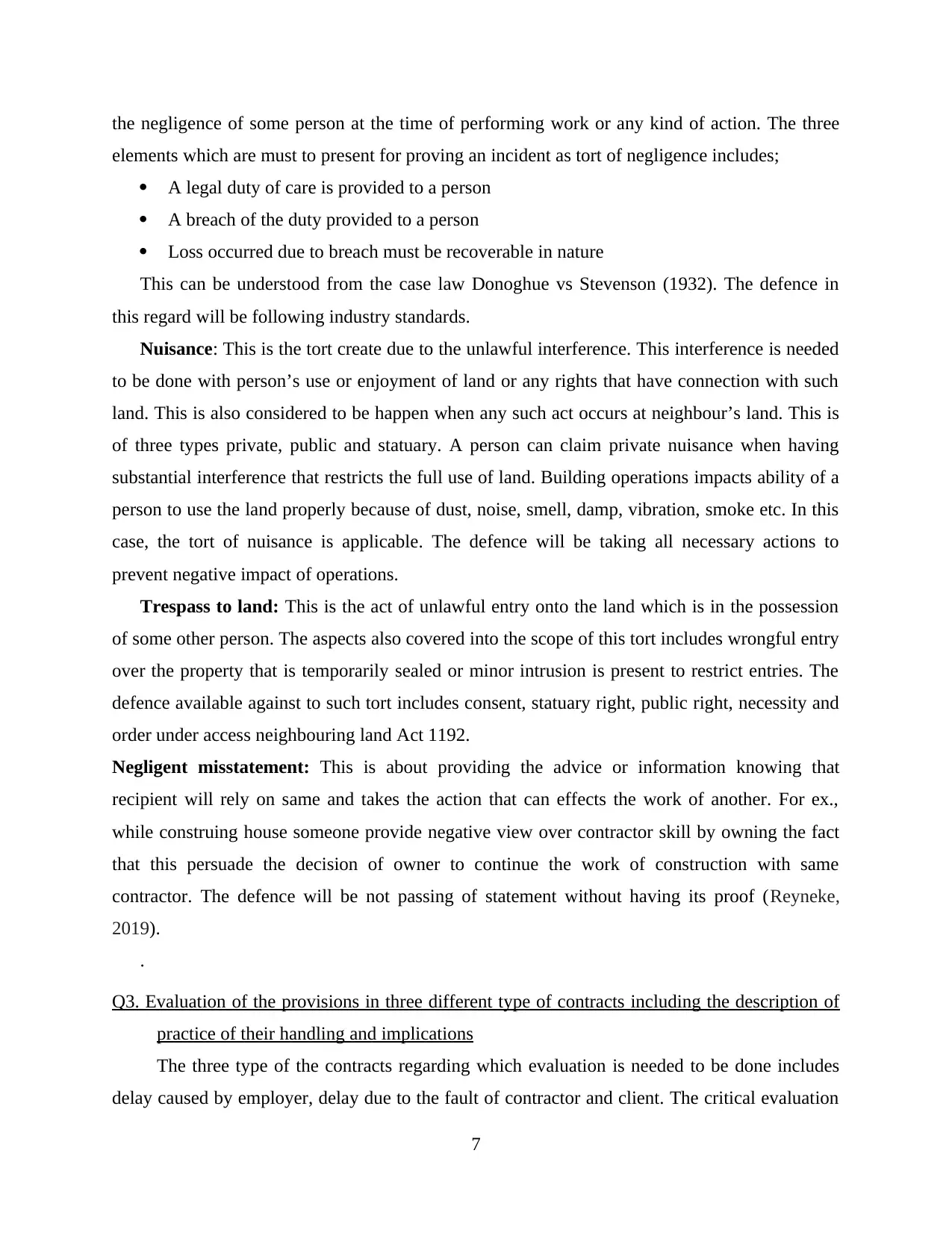
the negligence of some person at the time of performing work or any kind of action. The three
elements which are must to present for proving an incident as tort of negligence includes;
A legal duty of care is provided to a person
A breach of the duty provided to a person
Loss occurred due to breach must be recoverable in nature
This can be understood from the case law Donoghue vs Stevenson (1932). The defence in
this regard will be following industry standards.
Nuisance: This is the tort create due to the unlawful interference. This interference is needed
to be done with person’s use or enjoyment of land or any rights that have connection with such
land. This is also considered to be happen when any such act occurs at neighbour’s land. This is
of three types private, public and statuary. A person can claim private nuisance when having
substantial interference that restricts the full use of land. Building operations impacts ability of a
person to use the land properly because of dust, noise, smell, damp, vibration, smoke etc. In this
case, the tort of nuisance is applicable. The defence will be taking all necessary actions to
prevent negative impact of operations.
Trespass to land: This is the act of unlawful entry onto the land which is in the possession
of some other person. The aspects also covered into the scope of this tort includes wrongful entry
over the property that is temporarily sealed or minor intrusion is present to restrict entries. The
defence available against to such tort includes consent, statuary right, public right, necessity and
order under access neighbouring land Act 1192.
Negligent misstatement: This is about providing the advice or information knowing that
recipient will rely on same and takes the action that can effects the work of another. For ex.,
while construing house someone provide negative view over contractor skill by owning the fact
that this persuade the decision of owner to continue the work of construction with same
contractor. The defence will be not passing of statement without having its proof (Reyneke,
2019).
.
Q3. Evaluation of the provisions in three different type of contracts including the description of
practice of their handling and implications
The three type of the contracts regarding which evaluation is needed to be done includes
delay caused by employer, delay due to the fault of contractor and client. The critical evaluation
7
elements which are must to present for proving an incident as tort of negligence includes;
A legal duty of care is provided to a person
A breach of the duty provided to a person
Loss occurred due to breach must be recoverable in nature
This can be understood from the case law Donoghue vs Stevenson (1932). The defence in
this regard will be following industry standards.
Nuisance: This is the tort create due to the unlawful interference. This interference is needed
to be done with person’s use or enjoyment of land or any rights that have connection with such
land. This is also considered to be happen when any such act occurs at neighbour’s land. This is
of three types private, public and statuary. A person can claim private nuisance when having
substantial interference that restricts the full use of land. Building operations impacts ability of a
person to use the land properly because of dust, noise, smell, damp, vibration, smoke etc. In this
case, the tort of nuisance is applicable. The defence will be taking all necessary actions to
prevent negative impact of operations.
Trespass to land: This is the act of unlawful entry onto the land which is in the possession
of some other person. The aspects also covered into the scope of this tort includes wrongful entry
over the property that is temporarily sealed or minor intrusion is present to restrict entries. The
defence available against to such tort includes consent, statuary right, public right, necessity and
order under access neighbouring land Act 1192.
Negligent misstatement: This is about providing the advice or information knowing that
recipient will rely on same and takes the action that can effects the work of another. For ex.,
while construing house someone provide negative view over contractor skill by owning the fact
that this persuade the decision of owner to continue the work of construction with same
contractor. The defence will be not passing of statement without having its proof (Reyneke,
2019).
.
Q3. Evaluation of the provisions in three different type of contracts including the description of
practice of their handling and implications
The three type of the contracts regarding which evaluation is needed to be done includes
delay caused by employer, delay due to the fault of contractor and client. The critical evaluation
7
Paraphrase This Document
Need a fresh take? Get an instant paraphrase of this document with our AI Paraphraser
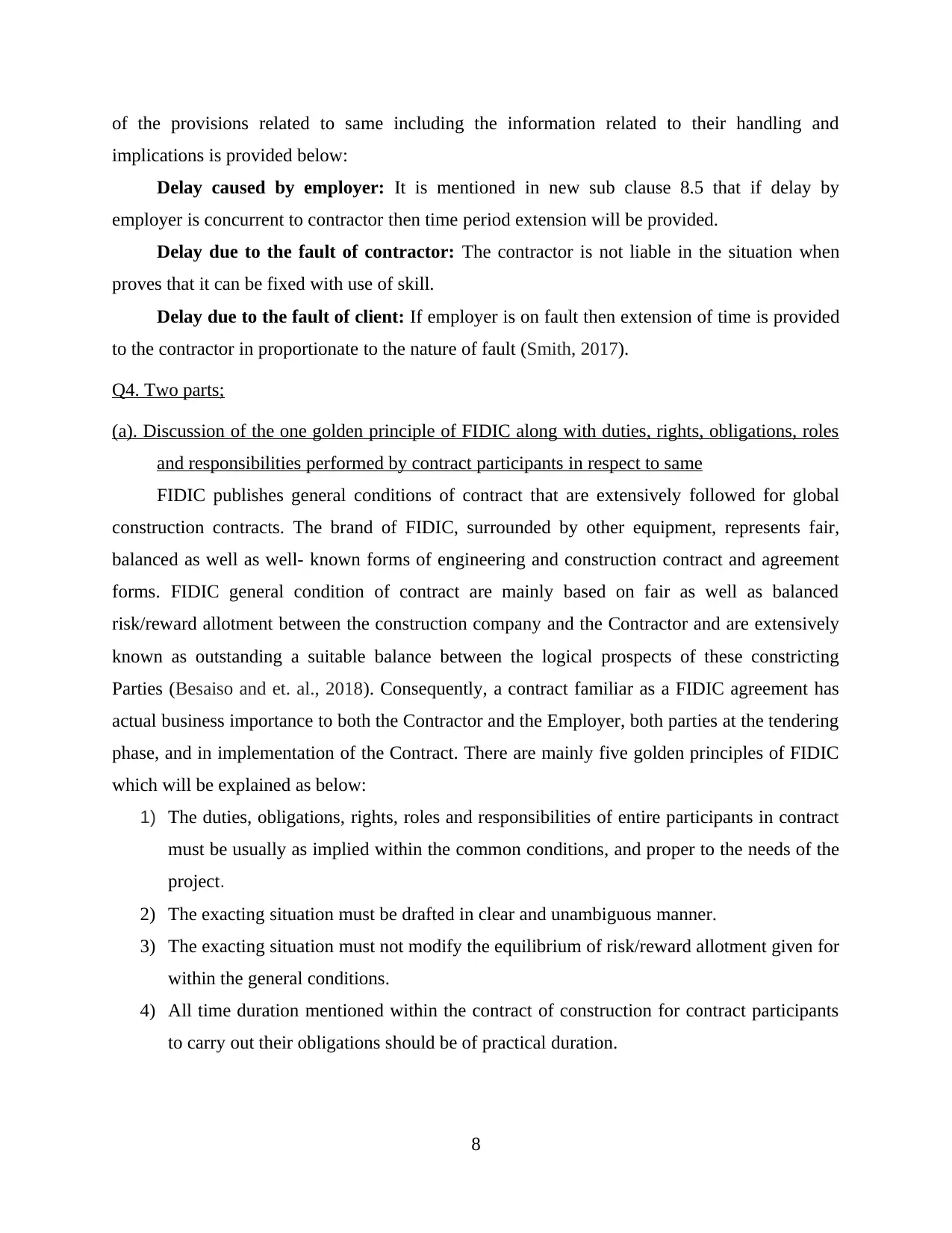
of the provisions related to same including the information related to their handling and
implications is provided below:
Delay caused by employer: It is mentioned in new sub clause 8.5 that if delay by
employer is concurrent to contractor then time period extension will be provided.
Delay due to the fault of contractor: The contractor is not liable in the situation when
proves that it can be fixed with use of skill.
Delay due to the fault of client: If employer is on fault then extension of time is provided
to the contractor in proportionate to the nature of fault (Smith, 2017).
Q4. Two parts;
(a). Discussion of the one golden principle of FIDIC along with duties, rights, obligations, roles
and responsibilities performed by contract participants in respect to same
FIDIC publishes general conditions of contract that are extensively followed for global
construction contracts. The brand of FIDIC, surrounded by other equipment, represents fair,
balanced as well as well- known forms of engineering and construction contract and agreement
forms. FIDIC general condition of contract are mainly based on fair as well as balanced
risk/reward allotment between the construction company and the Contractor and are extensively
known as outstanding a suitable balance between the logical prospects of these constricting
Parties (Besaiso and et. al., 2018). Consequently, a contract familiar as a FIDIC agreement has
actual business importance to both the Contractor and the Employer, both parties at the tendering
phase, and in implementation of the Contract. There are mainly five golden principles of FIDIC
which will be explained as below:
1) The duties, obligations, rights, roles and responsibilities of entire participants in contract
must be usually as implied within the common conditions, and proper to the needs of the
project.
2) The exacting situation must be drafted in clear and unambiguous manner.
3) The exacting situation must not modify the equilibrium of risk/reward allotment given for
within the general conditions.
4) All time duration mentioned within the contract of construction for contract participants
to carry out their obligations should be of practical duration.
8
implications is provided below:
Delay caused by employer: It is mentioned in new sub clause 8.5 that if delay by
employer is concurrent to contractor then time period extension will be provided.
Delay due to the fault of contractor: The contractor is not liable in the situation when
proves that it can be fixed with use of skill.
Delay due to the fault of client: If employer is on fault then extension of time is provided
to the contractor in proportionate to the nature of fault (Smith, 2017).
Q4. Two parts;
(a). Discussion of the one golden principle of FIDIC along with duties, rights, obligations, roles
and responsibilities performed by contract participants in respect to same
FIDIC publishes general conditions of contract that are extensively followed for global
construction contracts. The brand of FIDIC, surrounded by other equipment, represents fair,
balanced as well as well- known forms of engineering and construction contract and agreement
forms. FIDIC general condition of contract are mainly based on fair as well as balanced
risk/reward allotment between the construction company and the Contractor and are extensively
known as outstanding a suitable balance between the logical prospects of these constricting
Parties (Besaiso and et. al., 2018). Consequently, a contract familiar as a FIDIC agreement has
actual business importance to both the Contractor and the Employer, both parties at the tendering
phase, and in implementation of the Contract. There are mainly five golden principles of FIDIC
which will be explained as below:
1) The duties, obligations, rights, roles and responsibilities of entire participants in contract
must be usually as implied within the common conditions, and proper to the needs of the
project.
2) The exacting situation must be drafted in clear and unambiguous manner.
3) The exacting situation must not modify the equilibrium of risk/reward allotment given for
within the general conditions.
4) All time duration mentioned within the contract of construction for contract participants
to carry out their obligations should be of practical duration.
8
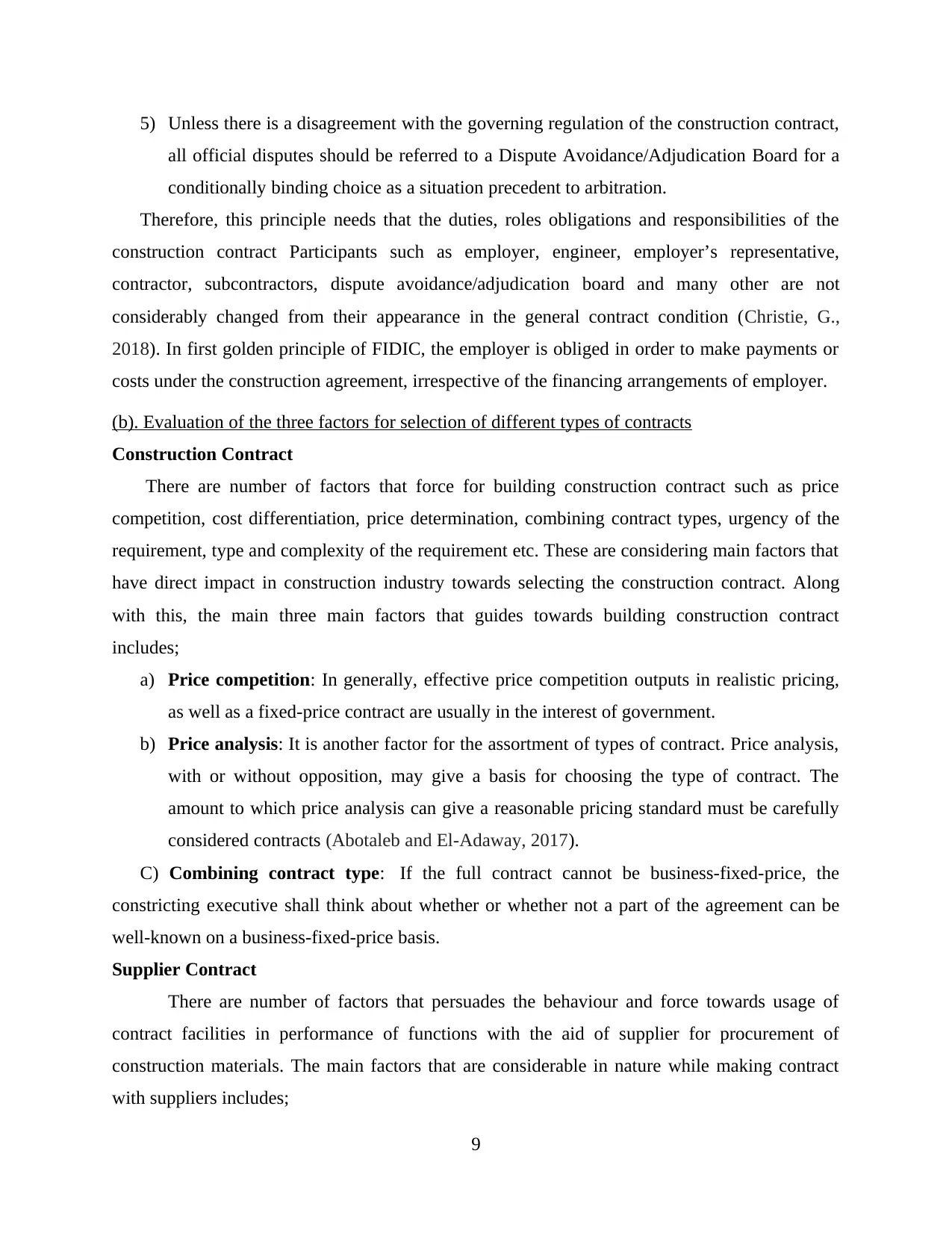
5) Unless there is a disagreement with the governing regulation of the construction contract,
all official disputes should be referred to a Dispute Avoidance/Adjudication Board for a
conditionally binding choice as a situation precedent to arbitration.
Therefore, this principle needs that the duties, roles obligations and responsibilities of the
construction contract Participants such as employer, engineer, employer’s representative,
contractor, subcontractors, dispute avoidance/adjudication board and many other are not
considerably changed from their appearance in the general contract condition (Christie, G.,
2018). In first golden principle of FIDIC, the employer is obliged in order to make payments or
costs under the construction agreement, irrespective of the financing arrangements of employer.
(b). Evaluation of the three factors for selection of different types of contracts
Construction Contract
There are number of factors that force for building construction contract such as price
competition, cost differentiation, price determination, combining contract types, urgency of the
requirement, type and complexity of the requirement etc. These are considering main factors that
have direct impact in construction industry towards selecting the construction contract. Along
with this, the main three main factors that guides towards building construction contract
includes;
a) Price competition: In generally, effective price competition outputs in realistic pricing,
as well as a fixed-price contract are usually in the interest of government.
b) Price analysis: It is another factor for the assortment of types of contract. Price analysis,
with or without opposition, may give a basis for choosing the type of contract. The
amount to which price analysis can give a reasonable pricing standard must be carefully
considered contracts (Abotaleb and El-Adaway, 2017).
C) Combining contract type: If the full contract cannot be business-fixed-price, the
constricting executive shall think about whether or whether not a part of the agreement can be
well-known on a business-fixed-price basis.
Supplier Contract
There are number of factors that persuades the behaviour and force towards usage of
contract facilities in performance of functions with the aid of supplier for procurement of
construction materials. The main factors that are considerable in nature while making contract
with suppliers includes;
9
all official disputes should be referred to a Dispute Avoidance/Adjudication Board for a
conditionally binding choice as a situation precedent to arbitration.
Therefore, this principle needs that the duties, roles obligations and responsibilities of the
construction contract Participants such as employer, engineer, employer’s representative,
contractor, subcontractors, dispute avoidance/adjudication board and many other are not
considerably changed from their appearance in the general contract condition (Christie, G.,
2018). In first golden principle of FIDIC, the employer is obliged in order to make payments or
costs under the construction agreement, irrespective of the financing arrangements of employer.
(b). Evaluation of the three factors for selection of different types of contracts
Construction Contract
There are number of factors that force for building construction contract such as price
competition, cost differentiation, price determination, combining contract types, urgency of the
requirement, type and complexity of the requirement etc. These are considering main factors that
have direct impact in construction industry towards selecting the construction contract. Along
with this, the main three main factors that guides towards building construction contract
includes;
a) Price competition: In generally, effective price competition outputs in realistic pricing,
as well as a fixed-price contract are usually in the interest of government.
b) Price analysis: It is another factor for the assortment of types of contract. Price analysis,
with or without opposition, may give a basis for choosing the type of contract. The
amount to which price analysis can give a reasonable pricing standard must be carefully
considered contracts (Abotaleb and El-Adaway, 2017).
C) Combining contract type: If the full contract cannot be business-fixed-price, the
constricting executive shall think about whether or whether not a part of the agreement can be
well-known on a business-fixed-price basis.
Supplier Contract
There are number of factors that persuades the behaviour and force towards usage of
contract facilities in performance of functions with the aid of supplier for procurement of
construction materials. The main factors that are considerable in nature while making contract
with suppliers includes;
9
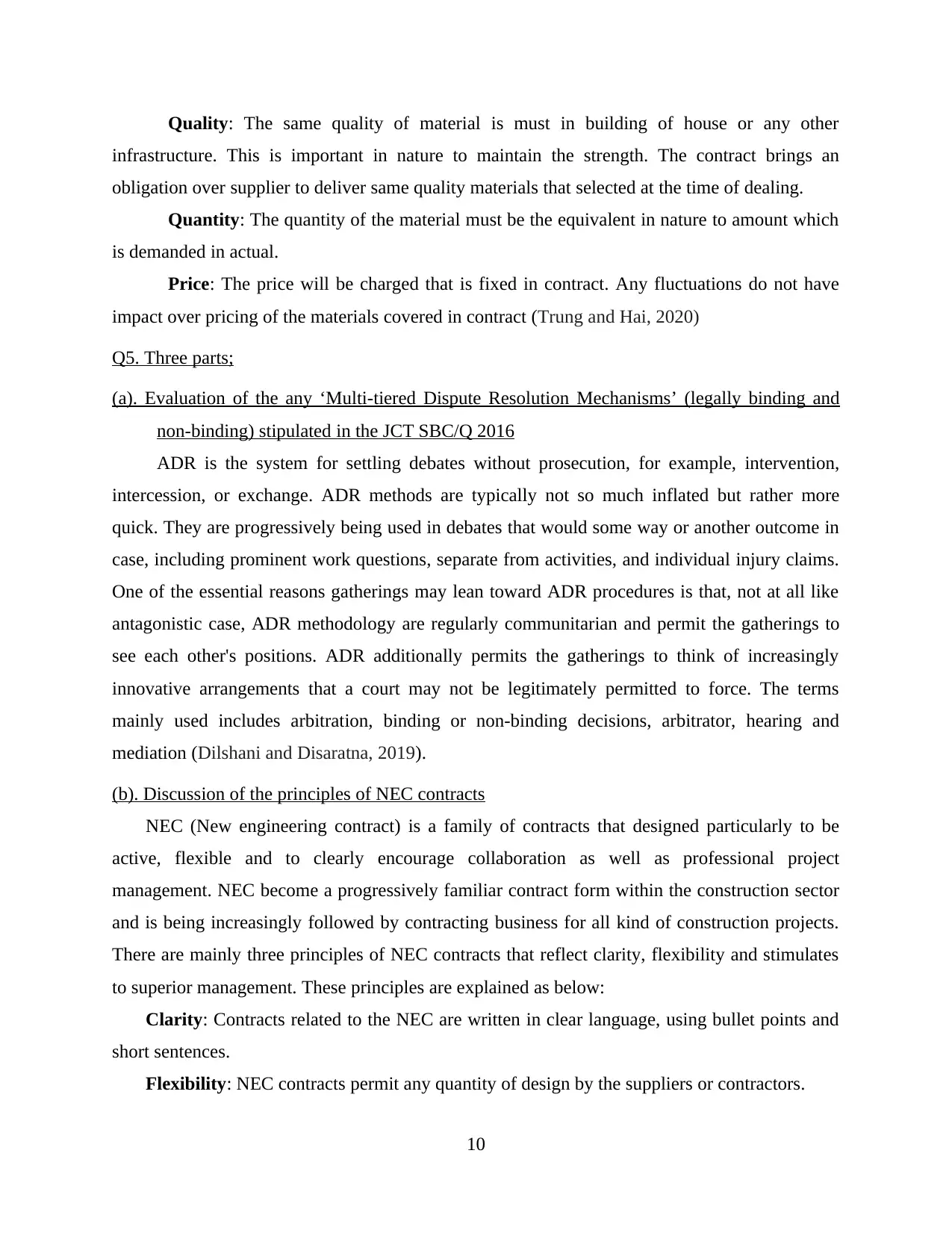
Quality: The same quality of material is must in building of house or any other
infrastructure. This is important in nature to maintain the strength. The contract brings an
obligation over supplier to deliver same quality materials that selected at the time of dealing.
Quantity: The quantity of the material must be the equivalent in nature to amount which
is demanded in actual.
Price: The price will be charged that is fixed in contract. Any fluctuations do not have
impact over pricing of the materials covered in contract (Trung and Hai, 2020)
Q5. Three parts;
(a). Evaluation of the any ‘Multi-tiered Dispute Resolution Mechanisms’ (legally binding and
non-binding) stipulated in the JCT SBC/Q 2016
ADR is the system for settling debates without prosecution, for example, intervention,
intercession, or exchange. ADR methods are typically not so much inflated but rather more
quick. They are progressively being used in debates that would some way or another outcome in
case, including prominent work questions, separate from activities, and individual injury claims.
One of the essential reasons gatherings may lean toward ADR procedures is that, not at all like
antagonistic case, ADR methodology are regularly communitarian and permit the gatherings to
see each other's positions. ADR additionally permits the gatherings to think of increasingly
innovative arrangements that a court may not be legitimately permitted to force. The terms
mainly used includes arbitration, binding or non-binding decisions, arbitrator, hearing and
mediation (Dilshani and Disaratna, 2019).
(b). Discussion of the principles of NEC contracts
NEC (New engineering contract) is a family of contracts that designed particularly to be
active, flexible and to clearly encourage collaboration as well as professional project
management. NEC become a progressively familiar contract form within the construction sector
and is being increasingly followed by contracting business for all kind of construction projects.
There are mainly three principles of NEC contracts that reflect clarity, flexibility and stimulates
to superior management. These principles are explained as below:
Clarity: Contracts related to the NEC are written in clear language, using bullet points and
short sentences.
Flexibility: NEC contracts permit any quantity of design by the suppliers or contractors.
10
infrastructure. This is important in nature to maintain the strength. The contract brings an
obligation over supplier to deliver same quality materials that selected at the time of dealing.
Quantity: The quantity of the material must be the equivalent in nature to amount which
is demanded in actual.
Price: The price will be charged that is fixed in contract. Any fluctuations do not have
impact over pricing of the materials covered in contract (Trung and Hai, 2020)
Q5. Three parts;
(a). Evaluation of the any ‘Multi-tiered Dispute Resolution Mechanisms’ (legally binding and
non-binding) stipulated in the JCT SBC/Q 2016
ADR is the system for settling debates without prosecution, for example, intervention,
intercession, or exchange. ADR methods are typically not so much inflated but rather more
quick. They are progressively being used in debates that would some way or another outcome in
case, including prominent work questions, separate from activities, and individual injury claims.
One of the essential reasons gatherings may lean toward ADR procedures is that, not at all like
antagonistic case, ADR methodology are regularly communitarian and permit the gatherings to
see each other's positions. ADR additionally permits the gatherings to think of increasingly
innovative arrangements that a court may not be legitimately permitted to force. The terms
mainly used includes arbitration, binding or non-binding decisions, arbitrator, hearing and
mediation (Dilshani and Disaratna, 2019).
(b). Discussion of the principles of NEC contracts
NEC (New engineering contract) is a family of contracts that designed particularly to be
active, flexible and to clearly encourage collaboration as well as professional project
management. NEC become a progressively familiar contract form within the construction sector
and is being increasingly followed by contracting business for all kind of construction projects.
There are mainly three principles of NEC contracts that reflect clarity, flexibility and stimulates
to superior management. These principles are explained as below:
Clarity: Contracts related to the NEC are written in clear language, using bullet points and
short sentences.
Flexibility: NEC contracts permit any quantity of design by the suppliers or contractors.
10
Secure Best Marks with AI Grader
Need help grading? Try our AI Grader for instant feedback on your assignments.

Stimulate the superior management: Cleat actions and clear roles are defined, and there is
an obvious timescale for each and every action (Almăşan, A. and Bercea, L., 2020).
(c). Discussion of the Donoghue and Stevenson contribution to the tort of negligence
Donoghue sought £500 in compensation from Stevenson for gastroenteritis and shock that
she supposed were caused by the incident. The case originates its manner to the House of Lords
to make a decision if a sense of duty of care existed. In year 1932, the Law Lords provided their
acumen. By a majority of 3 to 2, the Law Lords concurred that Donoghue was owed an
obligation of care under what got known as the "neighbour values" and that she can take an
action against Stevenson. Donoghue confronted legitimate obstacles before getting her optimistic
decision. Weeks before she made a move against Stevenson, precisely the same court had chosen
two comparable cases in opposition to her position.
CONCLUSION
It has been concluded from the above report that importance of law is statuary in nature
in relation to the performance of any kind of function. This safeguards the interest of parties
along with provides the direction of working with standards. There are number of legal contracts
is the essential element of law that contributes in safe and reliable working.
11
an obvious timescale for each and every action (Almăşan, A. and Bercea, L., 2020).
(c). Discussion of the Donoghue and Stevenson contribution to the tort of negligence
Donoghue sought £500 in compensation from Stevenson for gastroenteritis and shock that
she supposed were caused by the incident. The case originates its manner to the House of Lords
to make a decision if a sense of duty of care existed. In year 1932, the Law Lords provided their
acumen. By a majority of 3 to 2, the Law Lords concurred that Donoghue was owed an
obligation of care under what got known as the "neighbour values" and that she can take an
action against Stevenson. Donoghue confronted legitimate obstacles before getting her optimistic
decision. Weeks before she made a move against Stevenson, precisely the same court had chosen
two comparable cases in opposition to her position.
CONCLUSION
It has been concluded from the above report that importance of law is statuary in nature
in relation to the performance of any kind of function. This safeguards the interest of parties
along with provides the direction of working with standards. There are number of legal contracts
is the essential element of law that contributes in safe and reliable working.
11
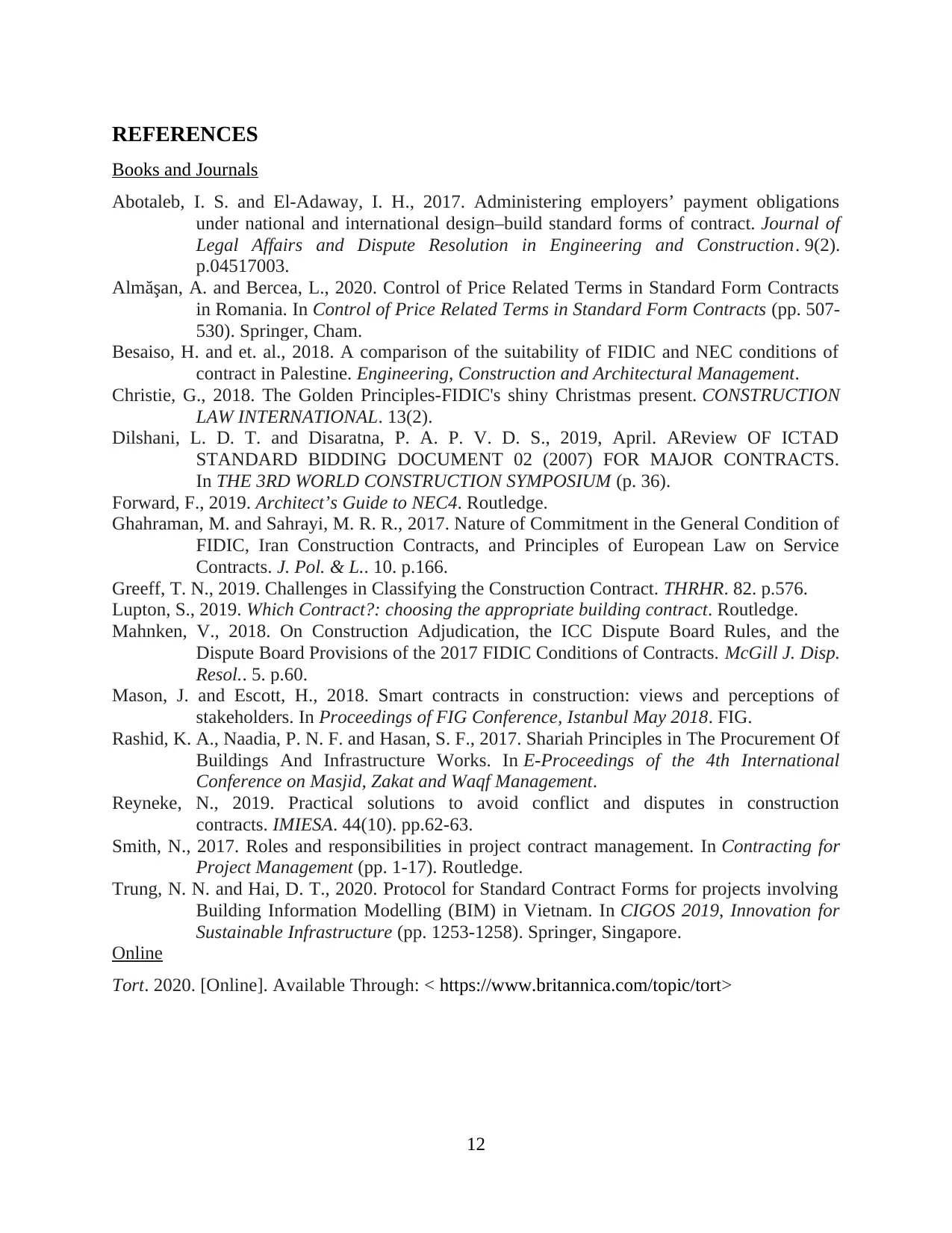
REFERENCES
Books and Journals
Abotaleb, I. S. and El-Adaway, I. H., 2017. Administering employers’ payment obligations
under national and international design–build standard forms of contract. Journal of
Legal Affairs and Dispute Resolution in Engineering and Construction. 9(2).
p.04517003.
Almăşan, A. and Bercea, L., 2020. Control of Price Related Terms in Standard Form Contracts
in Romania. In Control of Price Related Terms in Standard Form Contracts (pp. 507-
530). Springer, Cham.
Besaiso, H. and et. al., 2018. A comparison of the suitability of FIDIC and NEC conditions of
contract in Palestine. Engineering, Construction and Architectural Management.
Christie, G., 2018. The Golden Principles-FIDIC's shiny Christmas present. CONSTRUCTION
LAW INTERNATIONAL. 13(2).
Dilshani, L. D. T. and Disaratna, P. A. P. V. D. S., 2019, April. AReview OF ICTAD
STANDARD BIDDING DOCUMENT 02 (2007) FOR MAJOR CONTRACTS.
In THE 3RD WORLD CONSTRUCTION SYMPOSIUM (p. 36).
Forward, F., 2019. Architect’s Guide to NEC4. Routledge.
Ghahraman, M. and Sahrayi, M. R. R., 2017. Nature of Commitment in the General Condition of
FIDIC, Iran Construction Contracts, and Principles of European Law on Service
Contracts. J. Pol. & L.. 10. p.166.
Greeff, T. N., 2019. Challenges in Classifying the Construction Contract. THRHR. 82. p.576.
Lupton, S., 2019. Which Contract?: choosing the appropriate building contract. Routledge.
Mahnken, V., 2018. On Construction Adjudication, the ICC Dispute Board Rules, and the
Dispute Board Provisions of the 2017 FIDIC Conditions of Contracts. McGill J. Disp.
Resol.. 5. p.60.
Mason, J. and Escott, H., 2018. Smart contracts in construction: views and perceptions of
stakeholders. In Proceedings of FIG Conference, Istanbul May 2018. FIG.
Rashid, K. A., Naadia, P. N. F. and Hasan, S. F., 2017. Shariah Principles in The Procurement Of
Buildings And Infrastructure Works. In E-Proceedings of the 4th International
Conference on Masjid, Zakat and Waqf Management.
Reyneke, N., 2019. Practical solutions to avoid conflict and disputes in construction
contracts. IMIESA. 44(10). pp.62-63.
Smith, N., 2017. Roles and responsibilities in project contract management. In Contracting for
Project Management (pp. 1-17). Routledge.
Trung, N. N. and Hai, D. T., 2020. Protocol for Standard Contract Forms for projects involving
Building Information Modelling (BIM) in Vietnam. In CIGOS 2019, Innovation for
Sustainable Infrastructure (pp. 1253-1258). Springer, Singapore.
Online
Tort. 2020. [Online]. Available Through: < https://www.britannica.com/topic/tort>
12
Books and Journals
Abotaleb, I. S. and El-Adaway, I. H., 2017. Administering employers’ payment obligations
under national and international design–build standard forms of contract. Journal of
Legal Affairs and Dispute Resolution in Engineering and Construction. 9(2).
p.04517003.
Almăşan, A. and Bercea, L., 2020. Control of Price Related Terms in Standard Form Contracts
in Romania. In Control of Price Related Terms in Standard Form Contracts (pp. 507-
530). Springer, Cham.
Besaiso, H. and et. al., 2018. A comparison of the suitability of FIDIC and NEC conditions of
contract in Palestine. Engineering, Construction and Architectural Management.
Christie, G., 2018. The Golden Principles-FIDIC's shiny Christmas present. CONSTRUCTION
LAW INTERNATIONAL. 13(2).
Dilshani, L. D. T. and Disaratna, P. A. P. V. D. S., 2019, April. AReview OF ICTAD
STANDARD BIDDING DOCUMENT 02 (2007) FOR MAJOR CONTRACTS.
In THE 3RD WORLD CONSTRUCTION SYMPOSIUM (p. 36).
Forward, F., 2019. Architect’s Guide to NEC4. Routledge.
Ghahraman, M. and Sahrayi, M. R. R., 2017. Nature of Commitment in the General Condition of
FIDIC, Iran Construction Contracts, and Principles of European Law on Service
Contracts. J. Pol. & L.. 10. p.166.
Greeff, T. N., 2019. Challenges in Classifying the Construction Contract. THRHR. 82. p.576.
Lupton, S., 2019. Which Contract?: choosing the appropriate building contract. Routledge.
Mahnken, V., 2018. On Construction Adjudication, the ICC Dispute Board Rules, and the
Dispute Board Provisions of the 2017 FIDIC Conditions of Contracts. McGill J. Disp.
Resol.. 5. p.60.
Mason, J. and Escott, H., 2018. Smart contracts in construction: views and perceptions of
stakeholders. In Proceedings of FIG Conference, Istanbul May 2018. FIG.
Rashid, K. A., Naadia, P. N. F. and Hasan, S. F., 2017. Shariah Principles in The Procurement Of
Buildings And Infrastructure Works. In E-Proceedings of the 4th International
Conference on Masjid, Zakat and Waqf Management.
Reyneke, N., 2019. Practical solutions to avoid conflict and disputes in construction
contracts. IMIESA. 44(10). pp.62-63.
Smith, N., 2017. Roles and responsibilities in project contract management. In Contracting for
Project Management (pp. 1-17). Routledge.
Trung, N. N. and Hai, D. T., 2020. Protocol for Standard Contract Forms for projects involving
Building Information Modelling (BIM) in Vietnam. In CIGOS 2019, Innovation for
Sustainable Infrastructure (pp. 1253-1258). Springer, Singapore.
Online
Tort. 2020. [Online]. Available Through: < https://www.britannica.com/topic/tort>
12

13
1 out of 13
Related Documents
Your All-in-One AI-Powered Toolkit for Academic Success.
+13062052269
info@desklib.com
Available 24*7 on WhatsApp / Email
![[object Object]](/_next/static/media/star-bottom.7253800d.svg)
Unlock your academic potential
© 2024 | Zucol Services PVT LTD | All rights reserved.





